Military Tank
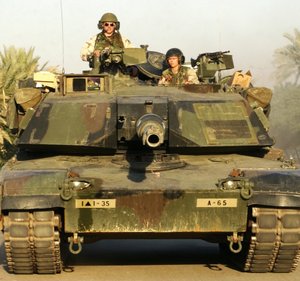
A tank is a tracked, armoured combat vehicle (armoured fighting vehicle), designed primarily to engage enemy forces by the use direct fire. A modern main battle tank (MBT) is distinguished by its high level of firepower, mobility and armour protection relative to other vehicles of its era. It can cross comparatively rough terrain at high speeds, but is fuel, maintenance, and ammunition-hungry and is logistically demanding. It has the heaviest armour of any vehicle on the battlefield, and carries a powerful weapon able to engage a wide variety of ground targets. It is among the most versatile and fearsome weapons on the battlefield, valued for its shock action against other troops and high survivability.
Tank organizations (or armoured units) are usually employed with infantry in combined arms warfare, supported by engineers, artillery, aircraft, and other support arms. If not properly protected, tanks can be vulnerable to attack by infantry, mines, artillery, aircraft strikes.
Tanks were first used in the First World War, to break the deadlock of the trenches, and they evolved to take the role of cavalry on the battlefield. The name "tank" first arose in British factories making the hulls of the first battle tanks: the workmen were given the impression they were constructing tracked water containers for the British Army, hence keeping the production of a fighting vehicle secret.
Tanks and tank tactics have undergone many generations of evolution over nearly a century. Although weapons systems and armour continue to be developed, many nations have been reconsidering the need for such heavy weaponry in a period characterised by unconventional warfare.
History
World War One: the first tanks
Having already seen armoured Rolls Royce cars used in 1914, and aware of schemes to create a tracked fighting vehicle, First Lord of the Admiralty Winston Churchill sponsored the Landships Committee to oversee development of this new weapon. The first successful prototype tank, nicknamed "Little Willie", was tested for the British Army on September 6, 1915. Although initially termed "landships" by the Admiralty, the initial vehicles were colloquially referred to as "water-carriers", later shortened to "tanks", to preserve secrecy. The word "tank" was used to give the workers the impression they were constructing tracked water containers for the British army in Mesopotamia, and it was made official on December 24, 1915.
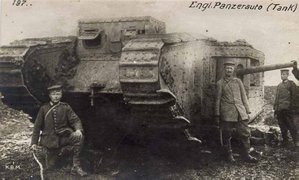
The first tank became operational when Captain H. W. Mortimore of the Royal Navy took a Mark I into action at Delville Wood during the Battle of the Somme on September 15, 1916. The French developed the Schneider CA1 working from Holt caterpillar tractors, and first used it on April 16, 1917. The first successful use of massed tanks in combat occurred at the Battle of Cambrai on November 20, 1917.
The tank would eventually make trench warfare obsolete, and the thousands of tanks fielded by French and British forces made a significant contribution to the war. Initial results with tanks were mixed, with problems in reliability causing considerable attrition rates when getting the tanks into combat and on the move. This forced the development of tanks such as the Mark IV, which rhomboid shape could navigate large obstacles, especially long trenches, more easily than many modern AFVs. Allied tanks continued to evolve during the war, while Germany mostly fielded a small number of captured tanks, and only made twenty of their native design, the A7V.
1920s to the end of Second World War
With the tank concept now established, several nations designed and built tanks between the two world wars. The British designs were the most advanced, due largely to their successes in WWI, the state of the other European powers France and Germany, and the detachment of the USA.
Throughout this period several "classes" of tanks were common, most of this development taking place in the UK. Light tanks, typically ten tons and less, were used primarily for scouting and generally mounted a light gun that was useful only against other light tanks. The "medium", or cruiser tank as it was known in the UK, were somewhat heavier and focused on long-range high-speed travel. Finally the heavy tank, or infantry tank, was heavily armoured andgenerally very slow. The overall idea was to use infantry tanks close concert with infantry to effect a breakthrough, their heavy armour allowing them to deal with antitank weapons the enemy would invariably carry. Once this combined force broke the enemy lines, groups of cruiser tanks would be sent through the gap, operating far behind the lines to attack supply lines and command units. This one-two punch was the basic combat philosophy of the British tank units, and adopted by the Germans as a major component of the Blitzkrieg concepts.
There was thought put into tank-against-tank combat, but the focus was on powerful antitank guns and similar weapons, including dedicated antitank vehicles. This was put to its fullest expression in the United States, where tanks were expected to avoid enemy armour, and let dedicated tank destroyer units deal with them. In practice these concepts soon proved dangerous. As the amount of armour on the battlefield increased, the chance of running into a tank grew to the point where every vehicle had to be an effective antitank vehicle as well. This led to a rapid up-armouring and up-gunning of almost all tank designs. Tank shape, previously guided purely by considerations of obstacle clearance, now became a trade-off, with a low profile desirable for stealth and stability.
World War II saw a series of advances in tank design. Germany for example, initially fielded lightly armoured and lightly armed tanks, such as the Panzer I, which was originally intended for training use only. These fast-moving tanks and other armoured vehicles were a critical element of the Blitzkrieg. However, they fared poorly in direct combat with British tanks and suffered severely against the Soviet T-34, which was superior in armour and weaponry. By the end of the war all forces had dramatically increased their firepower and armour; for instance, the Pz (Panzer) I had only two machine guns, and the Pz IV, the "heaviest" early war German design, had a low-velocity 75 mm design and weighed under twenty tonnes. By the end of the war the standard German medium tank, the Panther, mounted a powerful, high-velocity 75-mm gun and weighed forty-five tonnes.
Another major wartime advance was the introduction of radically improved suspension systems. Although this might not sound important, the quality of the suspension is the primary determinant of a tank's cross-country performance. Tanks with limited suspension travel will subject its crew to massive loads, making it difficult to operate the tank properly, and firing on the fly essentially impossible. Newer systems like the Christie suspension or the torion bar systems used in some Soviet, US, and German tanks dramatically improved performance, allowing the late-war Panther to travel cross country at speeds that would have been difficult for earlier designs to reach on-road.
By this time all tanks were equipped with radios, vastly improving the direction of units. Tank chassis were adapted to a wide range of military jobs, including mine clearance and engineering tasks. Some of these vehicles remain as other classes of armoured fighting vehicle. All major combatant powers also developed tank destroyers and assault guns—armoured vehicles carrying large calibre guns but often without turrets.
Turrets, which were not previously a universal feature on tanks, were recognised as the way forward. It was appreciated that if the tank's gun was to be used to engage armoured targets then it needed to be as large and powerful as possible, making having one large gun with an all-round field of fire vital. Multiple-turreted vehicles like the Soviet T-35 slowly died out during World War II, but never entirely disappeared. Most tanks retained at least one hull machine gun. Even post war, the M60 MBT had a smaller secondary turret for the commander's cupola.
The Cold War and beyond
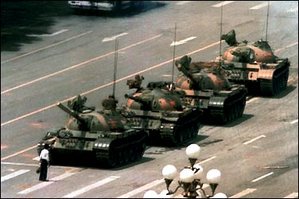
Jeff Widener (The Associated Press)
After WWII, tank development proceeded largely as it had been, with improvements to both the medium and heavy classes. Light tanks were now limited to the reconnaissance role and, in US use, airborne support as well. However, the weight limitations of air transport made a practical light tank almost impossible to build, and this class gradually disappeared over time.
But the seeds for a true transformation had already been working their way into existing designs. A combination of better suspensions and greatly improved engines allowed late-war mediums to outperform early-war heavies. With only slightly more armour and a somewhat larger engine to compensate, mediums were suddenly able to deal with almost all antitank weapons, even those mounted on heavy tanks, while at the same time having the mobility of the medium class. Many consider the turning point to be the Panther, which became the basis for almost every tank design after it. However the Panther was not terribly well armoured, and could not really deal with the heavy tanks on an equal basis.
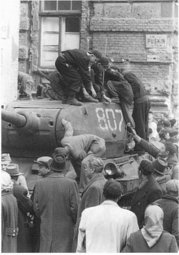
The first tank to get it all "right" is generally considered to be the British Centurion tank, which (in its later versions) was able to take hits from the infamous German 88 mm gun, was armed with the deadly 105 mm Royal Ordnance L7 that was superior to anything in the field, and could reach 35 km/h due to its excellent 650-hp Rolls-Royce Meteor engine. The Centurion replaced all British medium cruiser tanks and led to the demise of the heavy infantry tank class entirely, becoming what the British referred to as the Universal Tank, soon to be known as the main battle tank in most forces, abbreviated MBT.
As a result of heavy antitank guided missiles (ATGMs), the focus in development shifted away from just the tank's size, to the technologies within it. The long range of ATGM made it useless to concentrate resources into fewer heavy tanks, because they could no longer perform in the stand-off role, the one thing they were really useful for. So rather than just producing tanks with much thicker armour, radically more effective armour was implemented. Gun technology remained remarkably similar even to WWI-era gun technology, with most tanks in service still being manually loaded, but with big advances in shell effectiveness.
The continued need for vehicles that could carry and protect infantry, resulted in the development and use of combination vehicles, Cavalry Fighting Vehicles and Infantry Fighting Vehicles (CFVs and IFVs) such as the M2 Bradley, which combines the roles of a light tank and an APC.
Although the basic roles and traits of tanks were almost all developed by the end of WWI, the performance of twenty-first-century counterparts had increased by an order of magnitude. They had been refined dramatically in response to continually changing threats and requirements, especially the threat of other tanks. The advancing capabilities of tanks have been balanced by developments of other tanks and by continuous development of antitank weapons.
Design
The three traditional factors determining a tank's effectiveness are its firepower, mobility and protection. The psychological effect of a tank's imposing battlefield presence on enemy soldiers is called shock action.
Firepower is the ability of a tank to defeat a target. This includes the maximum distance at which targets can be engaged, the ability to engage moving targets, the speed with which multiple targets can be destroyed, the capability to defeat armoured vehicles or entrenched infantry, and the ability to continue fighting after damage has been sustained
Mobility is the speed and agility of driving cross-country, the types of terrain that can be covered, the size of obstacles, trenches, and water that can be crossed, the ability to cross small bridges, and the distance that can be covered before refuelling is required. "Strategic mobility" also includes the ability to travel at high speed on roads, and the ability to be carried on rail or truck transport. Traditionally AFV mobility is measured by the following metrics:
- engine power
- engine torque
- power-to-weight ratio
- road speed
- off-road speed (a somewhat nebulous figure given the possible variation)
- road range
- off-road range
- weight (bridge classification)
- ground pressure
- width of trench crossed
- vertical step climbed
- angle of slope that can be climbed
- angle of side slope that can be negotiated
- ground clearance
- unprepared fording depth
- prepared fording depth (if different)
Protection is the amount of armour, the type(s), how it is arranged (e.g., whether it is sloping or not), and which areas are given more protection (e.g., the turret and tracks) and which receive less (e.g., the rear of the chassis). It also includes low profile, low noise and thermal signature, active countermeasures, and other methods of avoiding enemy fire.
Tank design is traditionally considered to be a compromise between these three factors—it is not possible to maximise all three. For example, increasing protection by adding armour will increase weight and therefore decrease manoeuvrability; increasing firepower by using a larger gun will decrease both manoeuvrability and protection (due to decreased armour at the front of the turret).
How the compromise is achieved is influenced by a combination of factors, including military strategies, budget, geography, political will, and, in these modern times, the requirement to sell the tank to other countries.
Examples of how different countries are influenced in their decisions are as follows:
- Britain has historically always opted for better firepower and increased protection at the expense of some manoeuvrability. Britain has always maintained a small, highly trained professional army, and so tank crew survivability is important. Similarly, as limited resources may be available, the crew needs to be able to maintain their tanks in the field, and, with a succession of secondary sites available, are able to keep fighting if the primary site is out of action.
- The USA has an extremely large army with sophisticated weaponry and enormous resources. As their tanks will rarely be away from support and repair units, less emphasis is placed on the crew's ability to maintain the tank themselves or to continue fighting it once damage has been sustained.
- Germany's tanks were completely outmanoeuvred on the Russian front during WWII by the T-34, which was a major factor in their defeat. Also they lost more of their overly complex Tiger and Panther tanks due to mechanical breakdowns than enemy action. As a result, their tanks have since been incredibly manoeuvrable, with the resulting decrease particularly in protection. All demonstrations of post war German tanks focus on this ability. Enhanced reliability and lower maintenance requirements were also important design goals.
- Israel is a small, but relatively rich, nation, with limited man-power and surrounded by neighbours sworn to destroy it. Its primary concern is therefore crew-survivability, and to this end it is the only nation to have produced a modern tank with the engine placed at the front (to increase protection for the crew behind).
Weapons
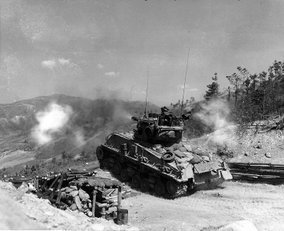
The main weapon of any modern tank is a single gun. Tank guns are among the largest calibre weapons in use on land, with only a few artillery weapons being larger. Although the calibre has not changed substantially since the end of the Second World War, modern guns are technologically superior. The current common sizes are 120-mm calibre for Western tanks and 125-mm for Eastern (Soviet and Chinese legacy) tanks. Tank guns have fired many types of rounds, but their current use is commonly limited to kinetic energy (KE) penetrators and high explosive (HE) rounds. Some tanks can fire missiles through the gun. Smoothbore (rather than rifled) guns are the dominant type of gun today. The British Army and the Indian Army are now the only ones to field main battle tanks with rifled guns.
Modern tank guns are generally fitted with thermal jackets which reduce the effect of uneven temperature or cooling of the barrel. Eg if it were to rain on a tank barrel the top would cool faster than the bottom, or a breeze on the left might cause the left side to cool faster then the right. This uneven cooling will cause the barrel to bend slightly and will effect long range accuracy. The thermal jacket reduces this uneven cooling.
Usually, tanks carry other armament for short range defence against infantry or targets where the use of the main weapon would be ineffective or wasteful. Typically, this is a small calibre (7.62 to 12.7 mm) machine gun mounted coaxially with the main gun. However, a couple of French tanks such as the AMX-30 and AMX-40 carry a coaxial 20-mm cannon that has a high rate of fire and can destroy lightly armoured vehicles. Additionally, many tanks carry a roof-mounted or commander's cupola machine gun for close-in ground or limited air defence. The 12.7-mm and 14.5-mm machine guns commonly carried on US and Russian tanks are also capable of destroying light armoured vehicles, such as APCs and possible IFVs at close range.
Some tanks have been adapted to specialised roles and have had unusual main armaments such as flame-throwers. These specialised weapons are now usually mounted on the chassis of an armoured personnel carrier.
Fire control
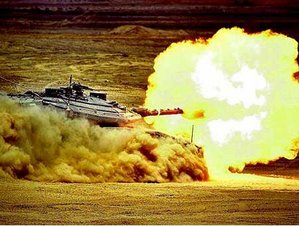
Historically, tank weapons were aimed through simple optical sights and laid onto target by hand, with windage estimated or assisted with the reticule. Range-finding was initially estimated, then estimated with the aid of the reticule (which use the measurement of angles, measured in the reticule of known sized objects as a method for range finding), which was later supplemented with stereoscopic optical range-finders, which remained the standard until the introduction of laser range-finder. Consequently, accuracy was limited at long range and made concurrent movement and shooting largely impossible.
Modern MBTs and upgraded MBTs use a laser range-finder but optical and reticule range-finders are still in use in older and less sophisticated vehicles. Modern tanks have a variety of sophisticated systems to make them more accurate. Gyroscopes are used to stabilise the main weapon; laser range-finders are used to measure the range to the target; computers calculate the appropriate elevation and aim-point, taking into account many factors such as wind speed, air temperature, humidity, the temperature of the gun, the speed of the target (calculated by taking at least two sightings of the target with the range-finder), the speed of the tank, the bend of the barrel, and the wear of the barrel. Night and infrared vision equipment is also commonly included. Laser target designators may also be used to illuminate targets for guided munitions. As a result modern tanks can fire reasonably accurately while moving.
Ammunition
There are several types of ammunition designed to defeat armour, including HESH (High Explosive Squash Head), HEAT (High Explosive Anti-Tank), APDS/APFSDS (Discarding Sabot designs). Non-KE-penetrator rounds have greater accuracy when fired from rifled guns, but can also be fin-stabilised in order to work with smoothbore guns.
Some tanks, including the M551 Sheridan, T-72, T-64, T-80, T-90, T-84, and PT-91 can fire ATGMs (AntiTank Guided Missiles) through their gun barrel. This functionality extends the effective combat range of the tank beyond the range afforded by conventional shells. It also provides the tank with a useful weapon against slow, low-flying airborne targets like helicopters. The United States has abandoned this concept, phasing the M551 and M60A2 out of their forces, but CIS countries continue to employ gun-missile systems in their main battle tanks.
Protection
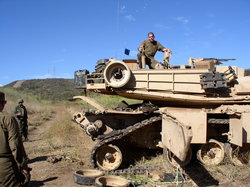
The main battle tank is the most heavily armoured vehicle in modern armies. Its armour is designed to protect the vehicle and crew against a wide variety of threats. Commonly, protection against kinetic energy penetrators fired by other tanks is considered the most important. Tanks are vulnerable to antitank guided missiles. Antitank mines, larger bombs, and direct artillery hits can also disable or destroy a tank. Tanks are especially vulnerable to airborne threats. Most modern MBTs do offer near complete protection from artillery shrapnel and lighter antitank weapons such as rocket propelled grenades. The amount of armour needed to protect against all conceivable threats from all angles would be far too heavy to be practical, so when designing an MBT much effort goes into finding the right balance between protection and weight.
Armour
Most armoured fighting vehicles are manufactured of hardened steel plate, or in some cases aluminium. The relative effectiveness of armour is expressed by comparison to rolled homogeneous armour.
Most armoured vehicles are best protected at the front, and their crews always strive to keep them pointed in the likeliest direction of the enemy. The thickest and best-sloped armour is on the glacis plate and the turret front. The sides have less armour and the rear and roof are least protected. World War Two American Sherman tank crews found the German Tigers to be practically invulnerable from the front, and were forced to employ flanking tactics to take them out. Today, tanks are vulnerable to specialised top-attack missile weapons and air attack, and even a Molotov cocktail on the engine deck is bad news for any tank.
Before the Second World War, Soviet tank designers started to slope the armour on several tanks, most famously the T-34. Angling armour plates greatly increases their effectiveness against projectiles, by increasing the effective perpendicular thickness of the armour, and by increasing the chance of deflection. German tank crews were said to be horrified to find that shots fired at T-34s would sometimes simply bounce off.
Even light infantry antitank weapons can immobilise a tank by damaging its suspension or track. Many tracked military vehicles have side skirts, protecting the suspension.
High explosive antitank weapons (HEAT), such as the bazooka, were a new threat in the Second World War. These weapons carry a warhead with a shaped charge, which focusses the force of an explosion into a narrow penetrating stream. Thin plates of spaced armour, steel mesh "RPG screens", or rubber skirts, were found to cause HEAT rounds to detonate too far from the main armour, greatly reducing their penetrating power.
Some antitank ammunition (HESH or HEP) uses flexible explosive material, which squashes against a vehicle's armour, and causes dangerous spalling of material inside the tank which may kill the crew without penetrating the armour. As a defence, some vehicles have a layer of anti-spall material lining their insides.
Since the 1970s, tanks have been protected by more complex perforated or composite armour, a sandwich of various alloys and ceramics. One of the best types of passive armour is the British-developed Chobham armour, which is comprised of spaced ceramic blocks contained by a resin fabric matrix between layers of conventional armour. A form of Chobham armour is encased in depleted uranium on the massively protected M1A1 Abrams MBT.
The Israeli Merkava tank takes the design of protection systems to an extreme, placing the engine and even the fuel between the crew and the direction of likely incoming fire.
Grenade launchers, smoke and passive defences
Most armoured vehicles carry smoke grenade launchers which can rapidly deploy a smoke screen to visually shield a withdrawal from an enemy ambush or attack. The smoke screen is very rarely used offensively, since attacking through it blocks the attacker's vision and will give the enemy an early indication of impending attack. Modern smoke grenades work in the infrared as well as visible spectrum of light.
Some smoke grenades are designed to make a very dense cloud capable of blocking the laser beams of enemy target designators or range finders and of course obscuring vision, reducing probability of a hit from visually aimed weapons, especially low speed weapons, such as antitank missiles which require the operator to keep the tank in sight for a relatively long period of time. In many MBTs, such as the French-built Leclerc, the smoke grenade launchers are also meant to launch tear gas grenades and anti-personnel fragmentation grenades. Many Israeli tanks contain small vertical mortar tubes which can be operated from within the tank, enhancing the anti-personnel capabilities and allowing it to engage targets which are behind obstacles. There have been proposals to equip other tanks with dual-purpose smoke/fragmentation grenade launchers that can be reloaded from the interior.
Prior to the widespread introduction of thermal imaging the most common smoke grenade in AFV launchers was white phosphorus which created a very rapid smoke screen as well as having a very useful incendiary effect against any infantry in the burst area (e.g., infantry attempting to close with hand placed charges or mines).
Since the advent of thermal imagers most tanks carry a smoke grenade that contains a plastic or rubber compound whose tiny burning fragments provide better obscurant qualities against thermal imagers.
Some tanks also have smoke generators which can generate smoke continuously, rather than the instantaneous, but short duration of smoke grenades. Generally smoke generators work by injecting fuel into the exhaust, which partially burns the fuel, but leaves sufficient unburned or partially burned particles to create a dense smoke screen.
Modern tanks are increasingly being fitted with passive defensive systems such as laser warning devices, which activate an alarm if the tank is "painted" by a laser range-finder or designator.
Other passive defences include radio warning devices, which provide warning if the tank is targeted by radar systems that are commonly used to guide antitank weapons such as a millimetre and other very short wave radar.
Countermeasures
Passive countermeasures, like the Russian Shtora system, attempt to jam the guidance systems of incoming guided missiles.
Explosive reactive armour, or ERA, is another major type of protection against high explosive antitank weapons, in which sections of armour explode to dissipate the focussed explosive force of a shaped charge warhead. Reactive armour is attached to the outside of an MBT in small, replaceable bricks.
Active protection systems go one step further than reactive armour. An APS uses radar or other sensing technology to automatically react to incoming projectiles. When the system detects hostile fire, it calculates a firing resolution and directs an explosive-launched counter-projectile to intercept or disrupt the incoming fire a few metres from the target.
Exposed crew
Paradoxically, a tank is usually in its safest state when the commander is in a personally unsafe position, riding in the open, head out of the turret, with no personal protection save his helmet and a flak jacket. In this rather high position the commander can see around the vehicle with no restrictions, and has the greatest chance of spotting enemy antitank operations or natural and unnatural obstacles which might immobilise or slow down the tank. Tank periscopes and other viewing devices give a sharply inferior field of vision and sense of the countryside, despite constant advances in optics and electronics. Thus, when a tank advances in hostile territory with hatches closed, the commander and the crew might be personally safer, but the tank as a whole is more at risk given the extremely reduced vision.
Mobility
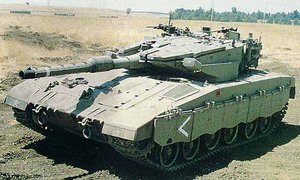
There are essentially two main aspects of mobility to consider, the tank's basic mobility such its speed across terrain and ability to climb obstacles, and its overall battlefield mobility such as range, what bridges it can cross, and what transport vehicles can move it. Essentially mobility of a tank is categorised as either Battlefield Mobility, Tactical Mobility, or Strategic Mobility. The first is a function of its engine performance and capability of its running gear and is determined by aspects such as acceleration, speed, vertical obstacle capability and so on. The second is the ability of the tank to be readily transported within a theatre of operation. The third is its ability to be transported from one theatre of operation to other, dependent on its weight, air portability and so on.
A main battle tank is designed to be very mobile and able to tackle most types of terrain. Its wide tracks disperse the heavy weight of the vehicle over a large area, resulting in a specific ground pressure that might be lower than that of a man's foot. The types of terrain that do pose a problem are usually extremely soft ground such as swamps, or rocky terrain scattered with large boulders. In "normal" terrain, a tank can be expected to travel at about 30 to 50 km/h. The road speed may be up to 70 km/h.
The logistics of getting from point A to point B are not as simple as they appear. On paper, or during any test drive of a few hours, a single tank offers better off-road performance than any wheeled fighting vehicle. On the road the fastest tank design is not much slower than the average wheeled fighting vehicle design.
In practice, the huge weight of the tank combined with the relative weakness of the track assembly makes the maximum road speed of a tank really a burst speed, which can be kept up for only a short time before there is a mechanical breakdown. Although the maximum off-road speed is lower, it cannot be kept up continuously for a day, given the variety and unpredictability of off-road terrain (with the possible exception of plains and sandy deserts).
Since an immobilised tank is an easy target for mortars, artillery, and the specialised tank hunting units of the enemy forces, speed is normally kept to a minimum, and every opportunity is used upon to move tanks on wheeled tank transporters and by railway instead of under their own power. Tanks invariably end up on railcars in any country with a rail infrastructure, because no army has enough wheeled transporters to carry all its tanks. Planning for railcar loading and unloading is crucial staff work, and railway bridges and yards are prime targets for enemy forces wishing to slow a tank advance.
When moving in a country or region with no rail infrastructure and few good roads, or a place with roads riddled by mines or frequent ambushes, the average speed of advance of a tank unit in a day is comparable to that of a man on a horse or bicycle. Frequent halts must be planned for preventive maintenance and verifications in order to avoid breakdowns during combat. This is in addition to the tactical halts needed so that the infantry or the air units can scout ahead for the presence of enemy antitank groups.
Another mobility issue is getting the tank to the theatre of operations. Tanks, especially main battle tanks, are extremely heavy, making it very difficult to airlift them. Using sea and ground transportation is slow, making tanks problematic for rapid reaction forces.
Some tank-like vehicles use wheels instead of tracks in order to increase road speed and decrease maintenance needs. These vehicles lack the superior off-road mobility of tracked vehicles, but might be more suited for rapid reaction forces due to increased strategic mobility.
Water operations
Most tanks water operations are limited to fording. The fording depth is usually limited by the height of the air intake of the engine, and to a lesser extent the driver's position. Typical fording depth for MBTs are 90 to 120 cm.
Deep fording
However, with preparation some tanks are able to ford considerably deeper depths. The West German Leopard I and Leopard II tanks can ford to a depth of several metres, when properly prepared and equipped with a snorkel. The Leopard snorkel, is in fact a series of rings which can be stacked to create a long tube. This tube is then fitted to the crew commander's hatch and provides air and a possible escape route for the crew. The height of the tube is limited to around three meters.
Some Russian/Soviet tanks are also able to perform deep fording operations, however unlike the Leopard, the Russian snorkel is only a few inches round and does not provide a crew escape path. Russian snorkels are also fixed in length, providing only a couple of metres of depth over the turret height.
This type of fording requires careful preparation of the tank and the ingress and egress sites on the banks of the water obstacle. However if properly planned and executed this type of operation adds considerable scope for surprise and flexibility in water crossing operations.
Amphibious tanks
Some light tanks such as the PT-76 are amphibious, typically being propelled in the water by hydrojets or by their tracks.
Often a fold down trim vane is erected to stop water washing over the bow of the tank and thus reducing the risk of the vehicle being swamped via the driver's hatch.
In World War II the Sherman Medium tank was made amphibious with the addition of a rubberised canvas screen to provide additional buoyancy. It was propelled by propellers driven by the main engine. This Sherman was referred to as the Sherman DD (Duplex Drive) and was used on D-Day to provide close and intimate fire support on the beaches during the initial landings. The Sherman DD could not fire when afloat as the buoyancy screen was higher than the gun. A number of these DDs sank due to rough weather in the channel. Those that did make it ashore, however, provided essential fire support in the first critical hours, getting off the beaches.
Power plants
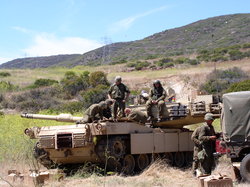
The tank's power-plant supplies power for moving the tank and for other tank systems, such as rotating the turret or electrical power a radio. Tanks fielded in WWI all used petrol (gasoline) engines as power-plants. In the Second World War there was a mix of power-plant types used; a lot of tank engines were adapted aircraft engines. As the Cold War started, tanks had almost all switched over to using diesel, improved multi-fuel versions of which are still common. Starting in the late 1970s, turbine engines began to appear.
The weight and type of power-plant (influenced by its transmission and drive train) largely determines how fast and mobile the tank is, but the terrain effectively limits the maximum speed of all tanks through the stress it puts on the suspension and the crew.
Multi-fuel diesels
All modern non-turbine tanks use a diesel engine because diesel fuel is less flammable and more economical than petrol. Some Soviet tanks used the dark smoke of burning diesel as an advantage and could intentionally burn fuel in the exhaust to create smoke for cover. Fuel tanks are commonly placed at the rear of the tank, though in some designs, such as the Israeli Merkava, the diesel fuel tanks are placed around the crew area to provide an additional layer of "armour." Fuel has often been stored in auxiliary tanks externally, or by other means such as in a small trailer towed behind the tank, able to be detached during combat.
Modern tank engines are in some cases multi-fuel engines, which can operate on diesel, petrol or similar fuels.
Gas turbines
Gas turbine engines have been used as an auxiliary power unit (APU) in some tanks, and are the main power plant in the Soviet/Russian T-80 and U.S. M1 Abrams. They are comparatively lighter and smaller than diesel engines, at the same level of sustained power output (the T-80 was dubbed the Flying Tank for its high mobility). However they are much less fuel efficient, especially at low RPMs, requiring larger fuel tanks to achieve the same combat range. Newer models of the M1 have a small secondary turbine engine as an APU to power the tank's systems while stationary, saving fuel by reducing the need to idle the main turbine.
Because of their lower efficiency, the thermal signature of a gas turbine is higher than a diesel engine at the same level of power output. On the other hand the acoustic signature of a tank with a muffled gas turbine can be quieter than a piston engine–powered one. The M1A2 was nicknamed Whispering Death for its quiet operation.[1]
A turbine is theoretically more reliable and easier to maintain than a piston-based engine, since it has a simpler construction with fewer moving parts. In practice, however, those parts experience a higher wear due to their higher working speeds. The turbine blades are also very sensitive to dust and fine sand, so that in desert operations special filters have to be carefully fitted and changed several times daily. An improperly fitted filter, or a single bullet or piece of shrapnel can render the filter useless, potentially damaging the engine. Piston engines also need well-maintained filters, but they are more resilient if the filter does fail.
Like most modern diesel engines used in tanks, gas turbines are usually multi-fuel engines.
Sonic, seismic, and thermal traces
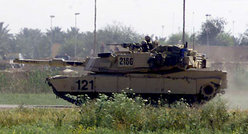
Stationary tanks can be well camouflaged in woodland and forested areas where there is natural cover, making detection and attack from the air more difficult. By contrast, in the open it is very hard to hide a tank. In both cases, however, once a tank starts its engine or begins to move it can be detected much more easily due to the heat and noise generated by its engine. The tank tracks across lands can be spotted from the air, and in the desert movement can stir up dust clouds.
A recently stopped stationary tank has a considerable heat signature. Indeed even if the tank itself is hidden, for example behind a hill, it is still possible for a skilled operator to detect the tank from the column of warmer air above the tank. This risk can be reduced somewhat by the use or thermal blankets which reduce the radiation of heat while the engine and tracks cool. Some camouflage nets are manufactured from unevenly distributed mix of materials with differing thermal properties, which are designed to "randomise" or at least reduce the regularity of the thermal signature of a tank.
Most tanks are powered by a diesel engine of a power comparable to a diesel locomotive. From the outside a tank smells, sounds, and feels quite like a diesel locomotive. The deep rumble of even a single tank can be heard a great distance on a quiet day, and the sharp diesel smell can be carried far downwind. When a tank stands still with engine running the land trembles around it. When moving, the vibrations are greater. The acoustic and seismic signatures of multi-fuel engines are comparable. The acoustic signature of a turbine engine is much greater: its high-pitched whine can be much more easily distinguished from other sounds, near or far.
The very large power output of a tank engine (typically in excess of 750kW or 1,000hp) ensures that it will always leave a distinct thermal signature. The unusually compact mass of metal of the tank hull dissipates heat in a fashion which marks it off sharply from other objects in the countryside. A moving tank is thus relatively easy to spot by good land-based or aerial infrared scanners. One of the reasons for the one-sided fighting during the Gulf Wars was that tanks like M1 Abrams had almost four times the night-time infrared scanning range of T-72s used by the Iraqi army. Another factor in the Gulf War was that, even when camouflaged and not moving, Iraqi tanks at night would cool at a different rate from their surroundings, making thermal detection easier.
Getting a tank to move proved to be important in the Kosovo conflict in 1999. During the initial few weeks of the conflict NATO air sorties were rather ineffective in destroying Serbian tanks. This changed in the final week of the conflict, when the Kosovo Liberation Army began to engage tanks. Although the KLA had little chance of destroying the tanks, their purpose was to get the tanks to move whereupon they could be more easily identified and destroyed by NATO air power.
Command, control, and communications
Commanding and co-ordinating a tank organisation in the field has always been subject to particular problems. Because of the isolation of small units, individual vehicles, and even the crewmen of a tank, special arrangements have had to be made. Armoured bulkheads, engine noise, intervening terrain, dust, and smoke, and the need to operate "hatches down" comprise severe detriments to communications.
Every action of a tank's crew, movement and fire, is ordered by its commander. In some early tanks, the crew commander's task was severely hampered by having to load or fire the main armament, or both. In many small armoured fighting vehicles, even into the late twentieth century, the crew commander would relay movement orders to the driver by kicks to his shoulders and back. Most modern AFVs are equipped with an intercom, allowing all crew members to talk to each other, and to operate the radio equipment. Some tanks have even been equipped with an external intercom on the rear, to allow co-operating infantry to talk to the crew.
In the earliest tank operations, communications between the members of an armoured company were accomplished using hand signals or handheld semaphore flags, and in some situations, by crew members dismounting and walking to another tank. In World War One, situation reports were sent back to headquarters by releasing carrier pigeons through vision slits. Signal flares, smoke, movement, and weapons fire are all used by experienced crews to co-ordinate their tactics.
From the 1930s to the '50s, most nations' armoured forces became equipped with radios, but visual signals are still used to reduce radio chatter. A modern tank is usually equipped with radio equipment allowing its crew to communicate on a company or battalion radio network, and possibly to monitor a higher-level network, to co-ordinate with other arms of service. Company or battalion commanders' tanks usually have an additional radio. Communications on a busy network are subject to a set of formalised language rules called radio voice procedure.
Most armoured forces operate with the crew commander, and possibly other crew members, "hatches up", for best possible situational awareness. When taking fire, or in potential NBC conditions, tank crews "button up" and only view the battlefield through vision slits or periscopes, severely reducing their ability to acquire targets and perceive hazards. Since the 1960s, a tank's commander has had progressively more sophisticated equipment for target acquisition. In a main battle tank, the commander has his own panoramic site (with night-vision equipment), allowing him to designate one or more new targets, while the gunner engages another. More advanced systems allow the commander to take control of the turret and fire the main armament in an emergency.
A recent development in AFV equipment is the increased integration of fire control, the laser range-finder, GPS data, and digital communications. U.S. tanks are fitted with digital computers which are connected into battlefield networks. These integrate known information on enemy targets and friendly units to greatly improve the tank commander's situational awareness. In addition to easing the reporting burden, these systems also allow for orders to be given complete with graphics and overlays, via the network.
See also
Vulnerability
Whilst being a tremendously powerful weapon and the undoubted king of the land battlefield, the tank is not invulnerable. In fact it is the tank's superiority which has focussed so much effort on improving antitank weapons.
Infantry
The tank is still vulnerable to infantry, especially in close country or built up areas. The armour and mobility of tanks, while usually notable assets, also makes them large and noisy. This can give enemy infantry the initiative, allowing them to spot, track and evade tanks until an opportunity presents itself for a stealthy counter-attack. This is why modern tactics insist on tanks being closely supported by friendly infantry.
For veteran troops, it is relatively easy for an infantry man to get close to a tank, especially if it is fully closed down (that is, the commander is fully inside the turret) as tanks have very poor visibility close in and especially to the sides and rear, unless the turret is pointing in that direction. If the crew commander is not closed down, that is, has exposed his head and perhaps upper body for the better view it affords him, then he can of course be shot.
In theory, it is easy for an infantry man to lie prone, wait behind a tree or other handy cover or inside a building and to quickly dash out as a tank passes. However, the tank is a fearsome war machine; it takes confidence, discipline and training to carry this out.
Once an infantry man is close to a tank he is invulnerable unless the crew expose themselves to attack him as the main gun and coaxial machine gun can not depress sufficiently to engage the close in infantry man. Where tanks are operating in groups this is less of a problem, since they can call on nearby tanks to fire on themselves with machine guns and other light weapons which are unlikely to damage a tank but which will drive off infantry.
Whilst many handheld infantry antitank rockets, missiles and grenades will not penetrate the front armour of a tank, they will generally speaking penetrate the weaker, rear, top and perhaps sides, as well as being able to easily damage the running gear to inflict an "M" (mobility) kill. Tanks are also vulnerable to hand placed antitank mines.
In addition in built up areas the tank is very vulnerable to attack from above—the roof and floor of the tank being traditionally the thinnest and weakest armoured surfaces.
Artillery
Traditionally artillery has not been very effective against tanks as the tank's armour could withstand any artillery round except a direct hit.
In the last thirty years however, a variety of artillery projectiles have been developed with attacking tanks in mind.
These include laser guided projectiles, such as the US Copperhead CLGP (Cannon Launched Guided Projectile) which virtually guarantee a direct hit on the thin top armour. In addition some of these CLGP's such as the Copperhead have HEAT warheads instead of common HE.
In addition to achieving a direct hit with guided projectiles, guided and unguided scatter munitions and submunitions have been developed. This a single artillery shell that contains a number of smaller munitions designed to attack a tank. At its simplest the shell bursts in the air and a number of shaped charged (HEAT) or HEDP (High Explosive Dual Purpose) bomblets or grenades rain down, with luck hitting the tank. If they do hit they will likely cause damage, despite their small size, since they are attacking the thin top armour.
A variation on this theme is replacing the top attack munitions with small antitank mines, which probably won't penetrate the armour but will blow off a track, leaving the tank vulnerable for destruction by other means.
A six-gun battery might be able to fire several hundred submunitions into an area in a minute or two.
More sophisticated are sub munitions with a homing capability. Once again the shell explodes above the tank position and dispenses a (usually smaller) number of sub-munitions. The munitions contain some circuitry to identify tanks, such as IR or millimetre radar. In order to allow the munition time to use its sensor the munition will often be deployed under a parachute. When a tank is identified a rocket is fired to direct the projectile at the tank.
All of the above bar the CLGP can be fired from medium (152/155-mm) artillery, both tube and rocket.
There has also been development of large calibre (81-mm and larger) guided mortar munitions with both internal (e.g., IR or radar) or external (i.e. laser designator) for attacking tanks.
Helicopters
The single biggest threat to the tank today is the antitank helicopter armed with ATGWs (Anti-Tank Guided Weapons) or cannon. The helicopter can typically fire from behind cover, use its greater mobility to attack from an unexpected quarter.
In addition most helicopter launched ATGWs have sufficient range that they can under the right conditions fire from ranges where the tank itself can not easily retaliate with its own weapons (though it is believed that some countries are developing anti helicopter weapons that can be fired from a main gun and some tank gunnery systems are probably capable of hitting a hovering or slow moving helicopter at considerable range) In addition even the light cannon of the helicopter gunship can be effective as they can attack the thin top armour of the tank.
Mines
The tank is still vulnerable to mines. Mines have the advantage of attacking the thinnest armour of the tank and can be well concealed.
In addition with modern scatterable mines, and in particular artillery scatterable mines, it is actually possible to lay a mine field around a moving tank formation.
As well as the traditional bottom attack mine, the scatter mine, the artillery delivered mine, or air delivered mine, there are also a number of side attack or "off route" mines available. These are mines that can be mounted on a vertical surface such as a wall, or tree, or mounted on a stand and are intended to be aimed at a road, track to other point a tank is likely to pass. Choke points such as bridges, fords, gates, underpasses, etc. are all likely spots. When the tank passes they fire into the side of the tank. The two common warheads for these mines are the ubiquitous HEAT and less commonly a platter charge. These mines can be fired by a human operator, simple mechanical actuator such as a tripwire or pressure plate, or by more sophisticated systems, such as seismic, IR or other electronic fusing systems. Some of the fusing systems are sophisticated enough to be able to discriminate between different classes of target and only attack specified classes of vehicles, e.g., ignore wheeled vehicles. Obviously a well placed off route mine will attempt to attack the rear or at worst the side of the tank, if at all possible. Some infantry antitank weapons can also be configured to act as off-route mines.
Aircraft
Many aircraft, including the A-10 Thunderbolt II, have been built specifically built for CAS, which in many cases include destroying tanks
The future of tanks through research and development
There has been much speculation as to how tanks will evolve for modern day conflicts. Current research involves making the tank invisible to radar by adapting stealth technologies originally designed for aircraft and a variety of luminosity and colour shaping technologies. Research is also ongoing in armour systems and new propulsion units.
One clear trend is the increasing number of electrical and communication systems on a tank, such as thermal scopes and higher powered radios. If tank designs switched to electrical motors like some other heavy construction equipment, rather than a direct drive transmission, or used electromagnetic guns, as is being studied for ships, there would still be a need for a good power-plant. The turbine engine long ago supplanted piston engines in both military aircraft and ships, but whether it will be successful in tanks has yet to be seen. It is also possible that other types of power-plants such as fuel cells will provide a viable option, and they have been experimented with. For example, a hybrid electric version of the M113 APC outperformed the conventional one in many areas, but only at the expense of smaller range.
References
- Ogorkiewicz, Richard M. Technology of Tanks. Coulsdon, Surrey : Jane's Information Group, 1991.
- Time Life Books editors. The Armored Fist. Alexandria, Va.: Time-Life Books, 1990.
- Weeks, John. Men Against Tanks: A History of Anti-Tank Warfare. New York: Mason Charter, 1975.
